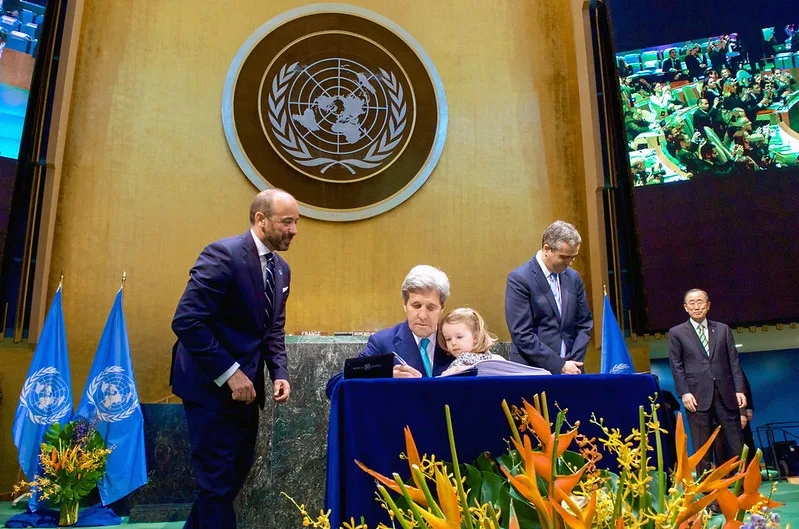Table of Contents
Table of Contents
Setting The Scene
It was 2016. The world turned its spotlight to Paris as leaders of 196 nations reunited momentarily. It was incomparable to any other. One figure stood among the crowd of diplomats and politicians, feeling the weight of the decision about to be made. The Paris Agreement wasn’t just another international accord. For this politician, it was the culmination of years of warnings on climate. These warnings had grown impossible to ignore. Rising seas and intensifying storms were becoming common. Erratic weather patterns were no longer afar but now stayed near. All of these were reshaping lives, homes, and economies. Every report they read and news story flashing images of flooded streets or parched lands had led up to this. The Agreement offered a way forward, but the stakes couldn’t be higher.
1.5°C
They had heard the figures many times. On paper, they looked small and insignificant. Warming was limited to below 2 degrees Celsius, aiming to reach 1.5 degrees. But standing there in that hall, they truly understood what those figures meant.
They saw the faces of the representatives of small island nations. These countries contributed negligible amounts of emissions to the climate, but they had already begun to see the adverse consequences of disappearing land from the rising ocean. To them, the difference between 2 degrees and 1.5 was a matter of survival. In their eyes, this wasn’t just policy—it was the fight for the future of their people.
And immediately, this politician’s mind went to his own country. He had watched the same struggles on his home soil: dependence on fossil fuels powering the economy for generations until it was now gruesomely clear that this was not a viable path forward. He said the Paris Agreement was a commitment to change. It was a pledge to reduce greenhouse gas emissions. It also aimed to adapt industries toward cleaner energy. Finally, it aimed to adapt to this new global reality. It would not be easy, but they knew it was necessary.
The Signing
As the Agreement was to be signed, the politician looked around. China, the United States, and the European Union stood firm in solidarity with the world’s most vulnerable countries. The moment was profound, with buzzing coherence in the air. For the first time, they felt together in realizing one common future—a future in which the planet’s health would be everybody’s joint liability, a future of hope and resolve.
It was not just a symbolic act to sign the Agreement. It required actual changes at home, which would mean for his country a transformation in the energy system, investment in renewables, and support for policies that would reduce emissions. He also knew that he needed to do his part to support those countries already facing the most critical impacts of climate change. The better-off nations, their own included, were obliged to extend the much-needed financial support. This support was essential for adaptation and mitigation in the most vulnerable regions. The mix of hope and urgency in their hearts hit the pen on the paper. It rang in their ears that the work was just about to begin, yet finally, in many years, the world was on a fighting chance. This Paris Agreement wasn’t just all other international diplomacy but a tipping point.
And in that hall, with representatives from all over the world standing together, one knew this was beyond mere numbers and policies. It was about the planet’s future; they were ready to fight for it. The sense of urgency mixed with hope at the signature of this Agreement lets the audience understand the dimensions of the magnitude of the state and the possibility of positive change. Just imagine if you were one of those politicians signing the Agreement. It was probably one of the most influential days of their lives. I am sure they retrospectively look upon it with immense pride.
Overview of the Paris Climate Agreement
The Paris Climate Agreement is a global pact aimed at combating climate change. It limits the increase in global temperatures to below 2°C above pre-industrial levels. Furthermore, there are increased efforts to restrict it to 1.5°C. This ambitious target is crucial to mitigate the worst effects of climate change, like rising sea levels and extreme weather events. Each participating country sets its own Nationally Determined Contributions (NDCs), which outline how they will reduce greenhouse gas emissions. The Agreement also includes a financial framework. Wealthier nations pledge support to developing countries. This helps them transition to sustainable energy sources and build resilience against climate impacts.
A critical feature of the Paris Agreement is its emphasis on transparency and accountability. Countries must regularly report their progress on emissions reductions and climate goals, following internationally agreed guidelines. This mechanism ensures that the global community can monitor the effectiveness of individual commitments and collective action. Moreover, the transparency framework enables peer reviews, increasing trust among nations and encouraging greater ambition over time. The Paris Agreement is a crucial blueprint for a cooperative global response to this urgent challenge as the climate crisis accelerates.
Reasons for Signing the Paris Climate Agreement
Countries worldwide have diverse motivations for signing the Paris Climate Agreement, driven by economic, environmental, and political factors. Economically, nations see the transition to clean energy as a critical opportunity to stimulate innovation, create green jobs, and ensure long-term growth. By committing to emission reductions, countries can position themselves at the forefront of the booming renewable energy market, attracting investment and promoting sustainable development. The Agreement provides a pathway to limit global warming. It promises a brighter future with a thriving green economy.
Public pressure and global leadership have also played pivotal roles in motivating countries to sign the Paris Agreement. Countries most vulnerable to climate impacts, like small island nations and developing countries, have long advocated for more decisive global climate action. Their efforts, supported by widespread public activism, put significant pressure on larger economies to act. Additionally, global leaders recognize that coordinated action is a moral obligation and a diplomatic opportunity to build international cooperation and secure a more stable and resilient world.
Who Signed the Paris Climate Agreement and Key Stakeholders
The Paris Climate Agreement has been signed by 196 parties, making it one of the most globally inclusive climate pacts ever established. Major carbon emitters such as the United States, China, and the European Union are among these signatories. They are responsible for a significant share of global greenhouse gas emissions. Their participation is crucial for the Agreement’s success, as their commitment to emission reductions directly influences the global trajectory of climate change. At the same time, smaller nations and vulnerable states, like island countries and developing nations, also signed the Agreement, as they are disproportionately affected by rising sea levels, extreme weather, and other climate impacts.
Critical stakeholders in the Paris Agreement range from governments to non-governmental organizations (NGOs), civil society, and youth movements. Governments are responsible for setting and achieving their Nationally Determined Contributions (NDCs). Still, NGOs and civil society organizations provide critical oversight, advocacy, and support for more decisive climate action. Youth movements like Fridays for Future have been particularly influential, pressuring governments to honor their commitments and prioritize climate change in policy decisions. These stakeholders are essential in implementing the Agreement and holding signatory countries accountable.
Impact of the Paris Climate Agreement
The Paris Climate Agreement profoundly impacts people, shaping their future in numerous ways, from the job market to public health. Young people will find new opportunities as the world approaches renewable energy and green technology. Because of this shift, future jobs will be in emerging sectors. These include clean energy, sustainable agriculture, and climate adaptation. This transition promises to create millions of green jobs, positioning today’s youth as leaders in a low-carbon economy. On the other hand, failure to meet the Agreement’s goals will undoubtedly exacerbate public health crises, with increased exposure to air pollution, heat waves, and food insecurity disproportionately affecting younger generations.
Youth activism has become a driving force in the global climate movement, with young people playing a pivotal and influential role in pushing for more decisive climate action.


Leave a Reply